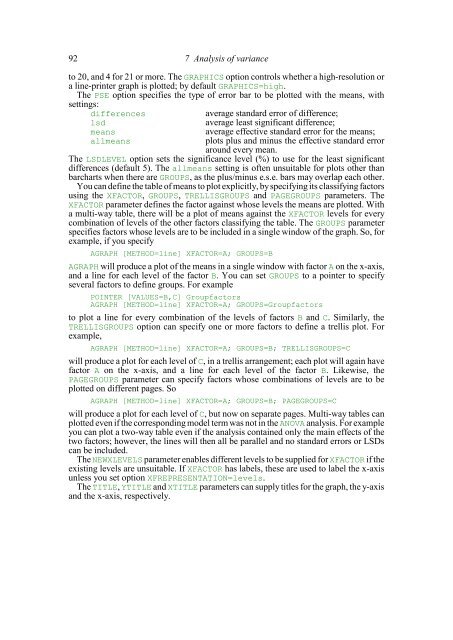Download pdf guide - VSN International
Download pdf guide - VSN International
Download pdf guide - VSN International
- No tags were found...
You also want an ePaper? Increase the reach of your titles
YUMPU automatically turns print PDFs into web optimized ePapers that Google loves.
92 7 Analysis of varianceto 20, and 4 for 21 or more. The GRAPHICS option controls whether a high-resolution ora line-printer graph is plotted; by default GRAPHICS=high.The PSE option specifies the type of error bar to be plotted with the means, withsettings:differencesaverage standard error of difference;lsdaverage least significant difference;meansallmeansaverage effective standard error for the means;plots plus and minus the effective standard erroraround every mean.The LSDLEVEL option sets the significance level (%) to use for the least significantdifferences (default 5). The allmeans setting is often unsuitable for plots other thanbarcharts when there are GROUPS, as the plus/minus e.s.e. bars may overlap each other.You can define the table of means to plot explicitly, by specifying its classifying factorsusing the XFACTOR, GROUPS, TRELLISGROUPS and PAGEGROUPS parameters. TheXFACTOR parameter defines the factor against whose levels the means are plotted. Witha multi-way table, there will be a plot of means against the XFACTOR levels for everycombination of levels of the other factors classifying the table. The GROUPS parameterspecifies factors whose levels are to be included in a single window of the graph. So, forexample, if you specifyAGRAPH [METHOD=line] XFACTOR=A; GROUPS=BAGRAPH will produce a plot of the means in a single window with factor A on the x-axis,and a line for each level of the factor B. You can set GROUPS to a pointer to specifyseveral factors to define groups. For examplePOINTER [VALUES=B,C] GroupfactorsAGRAPH [METHOD=line] XFACTOR=A; GROUPS=Groupfactorsto plot a line for every combination of the levels of factors B and C. Similarly, theTRELLISGROUPS option can specify one or more factors to define a trellis plot. Forexample,AGRAPH [METHOD=line] XFACTOR=A; GROUPS=B; TRELLISGROUPS=Cwill produce a plot for each level of C, in a trellis arrangement; each plot will again havefactor A on the x-axis, and a line for each level of the factor B. Likewise, thePAGEGROUPS parameter can specify factors whose combinations of levels are to beplotted on different pages. SoAGRAPH [METHOD=line] XFACTOR=A; GROUPS=B; PAGEGROUPS=Cwill produce a plot for each level of C, but now on separate pages. Multi-way tables canplotted even if the corresponding model term was not in the ANOVA analysis. For exampleyou can plot a two-way table even if the analysis contained only the main effects of thetwo factors; however, the lines will then all be parallel and no standard errors or LSDscan be included.The NEWXLEVELS parameter enables different levels to be supplied for XFACTOR if theexisting levels are unsuitable. If XFACTOR has labels, these are used to label the x-axisunless you set option XFREPRESENTATION=levels.The TITLE, YTITLE and XTITLE parameters can supply titles for the graph, the y-axisand the x-axis, respectively.
















